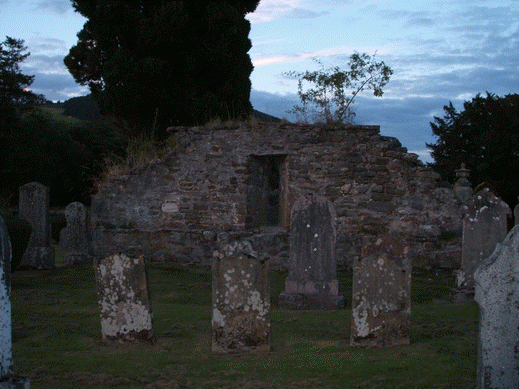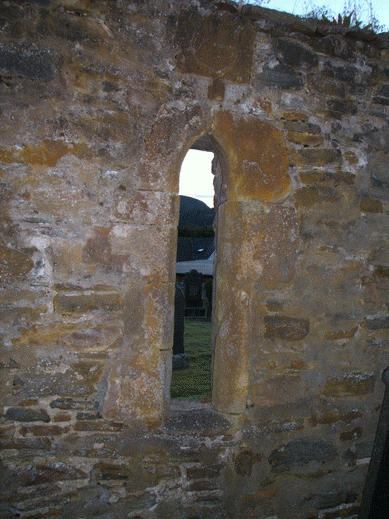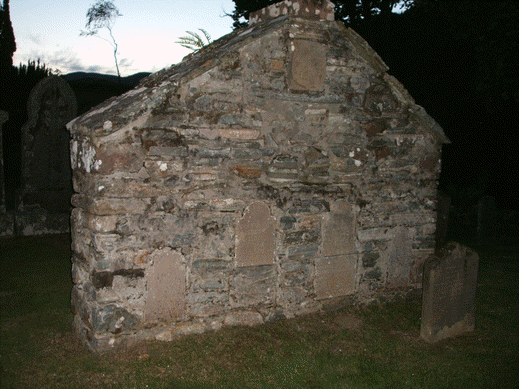Inverness Deanery
Urquhart
(Urchudainn mo Chrostáin)
Parish Church: OS Ref: NGR NH 515296 H.E.S. No: NH52NW 2 Dedication: St Mary
Associated Chapels: Bunloit {NGR NH 495240}; Corrimony {NGR NH 377301}; Glenmoriston - St Erchard {NGR NH 279127}; Glenmoriston - St Columba {NGR NH 420167}; Kilmichael {NGR NH 504303}; Pitkerrald {NGR NH 503296}; Croit Eonain {NGR NH 533303}; St Ninian's {NGR NH 528300}; Lenie {NGR NH 512262}; Kilmartin {NGR NH 43_30_}.
We should first start by dispelling some confusion. There are, in fact, three parishes in the north of Scoutlad which go by the name of Urquhart. The first is in the diocese of Ross, the second lies on the western shores of Loch Ness, and the third lies a few miles to the east of Elgin. The last of the three is, perhaps more properly, and certainly for our purposes, spelled Urquhard. The first is described elsewhere in our site. The second, lying on the shores of one of the most famous stretches of water in the World, is the focus of this page. The parish church is often called Kilmore (Kilmuir) which reflects its dedication to the Blessed Virgin Mary.
The area around Urquhart is remarkable for the extensive presence of remains, both physical and written, from the time of the Early Church. In addition, if we are to believe the evidence presented, then we must accept that here we have some of the very earliest remnants of Christianity in the north of Scotand. Within the bounds of the parish there are no less than five chapels, each one associated with a different individual whose history takes us back to 'the Golden Age of the Saints'.


Above and Below: Views of the Old Church of Kilmore at Drumnadrochit.
What ruins remain are those of the church which was built in 1630 but they rest upon the site of a predecessor which was mentioned in 1215. This site was abandoned in 1836 in favour of the new, and present, parish church.

The parish of Urquhart had St Drostán as its patron and, in consequence, acquired its Gaelic name of Urchudainn mo Chrostáin. 'St Drostan's Croft or Dwelling' lies on the top of a hillock west of where the House of Balmacaan once stood before it was demolished
As in many other Scottish parishes, the Romanists of later times changed the parish's first 'dedication', which celebrated an early native saint, to the more orthodox choice of the Blessed Virgin Mary.
At some point between 1208 and 1215, the church of Urquhart, together with that of Invera'an in Strathspey, was erected into a prebend of the cathedral at Elgin, which prebend was held by the Chancellor of the diocese up to the Reformation.1 As a consequence, Glenurquhart and Glenmoriston was served by a vicar who was responsible to the Chancellor.
In 1509, the parish was composed of three baronies - Glenmoriston, Corrimony, and Urquhart.
| Name | OS Grid Ref. | Extent | Comment |
|---|---|---|---|
| Drumbuie | NH 515305 | 1 dabhach | also known as Drumbae |
| Gartaly | NH 488311 | 1 dabhach | Upper & Lower Gartally |
| Sanct Ninian | NH 52_30_ | 1 dabhach | |
| Pitkerrald | NH 503298 | 1 dabhach | |
| Inchbruin | NH 44_30_ | 1 dabhach | |
| Bunloit | NH 50_24_ | 1 dabhach | |
| Bordland | NH 518291 | 1 dabhach | |
| Balmacaan | NH 489274 | 1 dabhach | |
| Corrimony | NH 377304 | 1 dabhach | |
| Auchbanachane | (unidentified) | 1 dabhach | |
| Tullichart | NH 27_13_ | 1 dabhach | |
| Invermorchen | NH 420170 | 1 dabhach | Invermoriston |
| Blaree | NH 381166 | 1 dabhach | Bhlaraidh |
| Dulschangy | NH 471301 | 1 dabhach | |
| Dundreggan | NH 324143 | 1 dabhach | |
| The Four Mekleis | c.NH 425300 | 1 dabhach | |
| Morall | (unidentified) | 1 dabhach | Ross (2003)2, with OS Refs added by David de Moravia |
1233 An agreement was reached whereby Andrew, bishop of Moray, gave to Alano Hostiarius, the half-dabhach of land of the church of Urquhart, then part of the prebend of the Chancellor. Alan then gave back the middle ground namely 'the half of the half-dabhach, to the church. He also was to pay 10 merks yearly to the church, ½ at Pentecost and ½ at Martinmas. Alan also gifts to the parish church the croft and toft of 4 acres assigned to it. [Moray. Reg., 83]
Other Churches and Chapels in the parish.
Bunloit - Lag an t-Seapail. Mackay tells us that, "There was in the times of Ss. Merchard, Columba and Curadan, a chapel at Lag an t-Seapail - 'the Hollow of the Chapel' - in Bunloit, where traces of old graves are still visible".3 The Ordnance Survey says that there is (now) no trace of a chapel. The graveyard at
Corrimony - Cill Churadain. There was a chapel of St Curetán4 within the burying-ground of Claodh Churadáin at Corrimony
Glenmoriston - St Erchard. Glenmoriston had its traditions regarding St Merchard.6 When in the district of Strathglass, he discovered a bell hidden in the ground at the foot of a certain tree, and resolved to found his church at the place where the bell rang for the third time of its own accord. After he reached Glenmoriston, the bell rang the first time at Suidh Mhercheird, 'St Merchard's Seat'; the second time at Fuaran Mhercheird, 'St Merchard's Well', at Ballintombuie
There is an ancient tradition that members of one of the five septs of the Clan Macdonald who inhabited Glenmoriston in the old days,8 Sliochd Alasdair Choire-Dho, who lived in Corri-Dho
Glenmoriston - St Columba. The chapel that was associated with Clachan Columchille
Kilmichael. A chapel of St Michael stood at Kilmichael, near Drumnadrochit. It was located at
Pitkerrald. Mackinlay states the "a pre-Reformation chapel to St Cyril once stood at Pitkerrald in Urquhart & Glenmoriston parish."11 (On modern Ordnance Survey maps it is marked as Pitkerralo which the O.S. have confirmed to me is a printing-error for Pitkerrald
St Adamnán's - Croit Eonain. Within the parish there was a piece of land which was known as Croit Eonain, 'St Adamnán's Croft'. This croft funded the chaplainry of St Adomnán which existed within the Chapel of St Ninian. There was no separate Chapel here dedicated to Adomnán but he is the supposed founder of the ancient muinntir not very far to the north at Abriachan (Bona) and it is reasonable to assume that he was active in Glenurquhart as well as at Abriachan. The location of the croft is unknown today but Mackay wrote the following: "St. Adamnán ... was commemorated in our Parish by Croft Adamnán - probably the hollow at Tychat
St Ninian's. There was a chapel known as Kill St Ninian or the Temple, in Urquhart parish. The district in its immediate neighbourhood is known in Gaelic as Slios an Trinnein - 'the hillside of St Ninian'.14 There was within it a chaplainry of St Columba. Today, in St Ninian's Episcopal Church in Glen Urquhart, built in 1853 and re-consecrated in 1952, is the so-called St Ninian's Stone, an excised cross-slab which came originally from the supposed ruined Knights Templar Chapel of St Ninian at Temple Pier, Drumnadrochit. It was kept for a while at Corrimony House before being incorporated into the altar of the Episcopal church. A number of historians now consider that Temple was the most northerly base of St Ninian, so this very early cross may have been seen by the Saint himself at the end of the 4th century.
However, there is considerable debate here, still, regarding the dedication of this chapel. Ross15 points out that its name is found as Killsanctninian in 1509, 16and Kilsancttringand in 1563.17 Watson has argued that the Gaelic place-names that comemmorate the saint in Urquhart - Cill an Truinnein, Teampull an Truinnein, and Slios an Truinnein - are Gaelicisations of Scots vernacular forms of the saint's name (Ringan).18 This would suggest that the Gaelic forms are more 'modern' than had hitherto been suggested and that there could have been an older dedication than that to St Ninian. Mackinlay also notes that there appears to have been a dedication to St Drostán in the dabhach of Saint Ninian - a chaplainry/altar.19 Ross goes further and suggests that, in fact, St Drostán was the original dedication of this chapel rather than St Ninian, but, given the evidence, we find his argument hard to accept. The parish as a whole was dedicated to St Drostán but this chapel seems to have commemorated St Ninian.
A charter of 1556 (vide infra) shows that the chaplainries of St Drostán, St Adomnán, and St Ninian had been combined into one 'benefice' before the Second Reformation. These deeds show that with the combined chaplainry went St Adomnán's Croft, and the croft and relics of St Drostán, consisting chiefly, if not exclusively, of his cross, which disappeared after the Protestant Reformation. In older times, the relics of St Drostán were under the charge of a Deoir or keeper who had a croft at Kil St Ninian (Croit an Deoir) which is mentioned in a rental of 1649 preserved at Castle Grant.20
The farm of Kil St Ninian extended from Abriachan to Drumbuie. It was at Kil St Ninian (Temple House), that the laird of Grant's tenants paid their money rent, and also delivered the rent which they paid in kind. Hence, it was called the Grange of Kil St Ninian as early as 1513,21 echoing the monastic use of 'granges' for the same purposes.
Lenie - Auchnahannet. This place-name is most revealing since Anoid and Annet are thought to signify the first, or mother church, of a district.22 Mackay (1914) suggests that this church "was probably the first built in Glen Urquhart". The site is at
Kilmartin. This place-name is a mystery! Although it points to a chapel or burying-ground there is no evidence of any kind that either existed here at any time in the past. These lands were called the four Meiklies and included Shewglie and Craskaig, sometime called Lakefield and now Kilmartin.23 In 1509, the four Mikleis were described as eight pound lands lying within the Barony of Corrimony.
Templar Commandery. Some say that there was a Commandery of the Order of Knights Templar at Teampal Ninian (An Teampull). The old chapel's Gaelic name included the word Teampull, which is simply a word sometimes used for a chapel or church. That has not stopped many modern references to it as a "temple" and, more fancifully still, the author of the inscription on the St Ninian's Cross taking the name as evidence of a link with the Knights Templar.
At Stirling, on the 8th day of December, 1509, the King created the lordship of Urquhart in favour of John Grant of Freuchie, and the two baronies of Corrymony and Glenmoriston for his two sons. Consequently, the whole of Urquhart and Glenmoriston became the property of the Grants with the notable exceptions (made by the King) of the Church lands of Achmonie, Pitkerrald Chapel, St Drostán's Croft at Balmacaan, St Adamnán's Croft at Tychat
Parish Clergy:
1556 (2 September) John Donaldson receives letters of induction to the Chaplainry of St Ninian, 40 shillings of land known as Pitkerrar/Petkarell {Pitkerrald
Induction was given by the delivery of the horns and ornments of the high altar, and of the keys and bell-ropes of the church.25
1. Moray Reg., 46.
2. Ross, A (2003) The Province of Moray, c.1000-1230. PhD Thesis submitted to the University of Aberdeen, 2003. Vol.i, 88-89; Vol.ii, 83.
3. Mackay, W (1914) Urquhart & Glenmoriston: olden times in a Highland parish., Inverness, 336.
4. Curetán is the same as St Curitan of Rosemarkie who is thought to have been active between c.690 and 710.
5. Mackinlay, J M (1914) Ancient Church Dedications in Scotland: Non-Scriptural Dedications, Edinburgh, 481.
6. Merchard is 'Mo Erchard', an honorific name-form meaning 'beloved Erchard'.
7. Mackinlay, J M (1914) Ancient Church Dedications in Scotland: Non-Scriptural Dedications, Edinburgh, 219.
8. The five Macdonald septs were - Clann Iain Ruaidh, Clann Iain Chaoil, Clann Eobhainn Bhain, Sliochd Ghilleasbuig, and Clann Alasdair Choire-Dho. [Mackay, W (1914) Urquhart & Glenmoriston: olden times in a Highland parish., Inverness, n83.]
9. Mackay, W (1914) Urquhart & Glenmoriston: olden times in a Highland parish., Inverness, n83.
10. Mackinlay, J M (1910) Ancient Church Dedications in Scotland: Scriptural Dedications, Edinburgh, 345.
11. Mackay, W (1914) Urquhart & Glenmoriston: olden times in a Highland parish., Inverness, 336.
12. Reg. Mag. Sig., Lib. XV., no.173; Chiefs of Grant, III., 51; Urquhart & Glenmoriston: olden times in a Highland parish, 78-79.
13. Mackay, W (1914) Urquhart & Glenmoriston: olden times in a Highland parish., Inverness, 335.
14. Mackinlay, J M (1914) Ancient Church Dedications in Scotland: Non-Scriptural Dedications, Edinburgh, 33.
15. Ross, A (2003) The Province of Moray, c.1000-1230. PhD Thesis submitted to the University of Aberdeen, 2003. Vol.i, 90-91.
16. NAS, GD248/9/1/13.
17. NAS, GD248/534/1.
18. Watson, J (1926) Thee History of the Celtic Placenames of Scotland, Edinburgh, 293-4.
19. Mackinlay, J M (1914) Ancient Church Dedications in Scotland: Non-Scriptural Dedications, Edinburgh, 217.
20. Macfarlane vol.3, 92.
21. Mackay, W (1914) Urquhart & Glenmoriston: olden times in a Highland parish., Inverness, 114.
22. 'Annait' is a 9th to 10th century term for church-site of any kind abandoned during that period, and not subsequently re-used as the site of a focal church. [MacDonald, A. (1973) ''Annat' in Scotland: A provisional review', Scot Stud, vol. 17, 2, 1973. Page(s): 139-40]
23. Mackay, W (1914) Urquhart & Glenmoriston: olden times in a Highland parish., Inverness, n80.
24. Fraser, Wm. (1883) The Chiefs of Grant, Edinburgh, vol.3, 122.
25. Fraser, Wm. (1883) The Chiefs of Grant, Edinburgh, vol.1, lxxxi.
e-mail: admin@cushnieent.com
© 2019 Cushnie Enterprises
